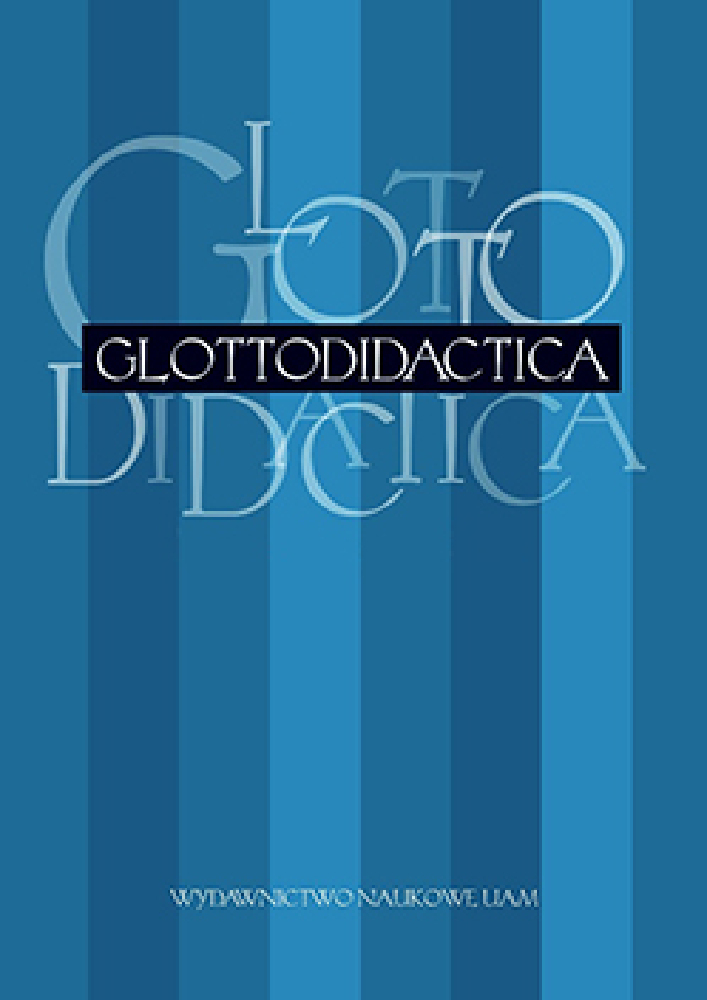Abstract
Language is considered a social phenomenon because all human beings communicate with their respective speech communities using the language of their own. Putnam’s theory of meaning combines such ingredients as the individual language experience world and social practice, all of which are ignored or downplayed by traditional theorizing about meaning. This article outlines some important aspects of Putnam’s idea and tries to answer the question of whether the stereotype semantics can solve the problem of meaning.References
Bartmiński, J., 1988a. Słownik ludowych stereotypów językowych. Zeszyt próbny. Wrocław: Wydawnictwo Uniwersytetu Wrocławskiego.
Bartmiński, J., 1988b. Definicja kognitywna jako narzędzie opisu konotacji. In: Bartmiński, J. (red.), Konotacja. Lublin: UMCS, 169–182.
Bartmiński, J., 1998. Podstawy lingwistycznych badań nad stereotypem – na przykładzie stereotypu ‘matki’. In: Język a kultura 12, 63–83.
Bosch, P., 1985. Kontexte, Stereotype und Dynamik der Bedeutungskonstitution. In: Rieger, B. (Hrsg.), Dynamik in der Bedeutungskonstitution. Hamburg: Buske, 143–162.
Busse, D., 1992. Textinterpretation. Sprachtheoretische Grundlagen einer explikativen Semantik. Opladen: Westdeutscher Verlag.
Dahlgren, K., 1978. The Nature of Linguistic stereotypes. In: Farkas, D. / Wesley, M.J. / Karol, W. Todrys (eds), Papers from the Parasession on the Lexicon, April 14–15. Chicago: Chicago Linguistic Society, 58–70.
Dahlgren, K., 1988. Naive Semantics for Natural Language Processing. Boston: Kluwer Academic Publishers.
Eikmeyer, H.-J. / Rieser, H., 1981. Meanings, Intentions and Stereotypes: A New Approach To Linguistic Semantics. In: Eikmeyer, H.-J. / Rieser, H. (eds), Words, Worlds, and Contexts. New Approaches in Word Semantics. Berlin / New York: de Gruyter, 133–150.
Fraas, C., 1996. Gebrauchswandel und Bedeutungsvarianz in Textnetzen: Die Konzepte IDENTITÄT und DEUTSCHE im Diskurs zur deutschen Einheit. Tübingen: Gunter Narr.
Grzegorczykowa, R., 1998. O rozumieniu prototypu i stereotypu we współczesnych teoriach. In: Język a kultura 12, 109–115.
Kilian, J., 2003. Wörter im Zweifel. Ansätze einer linguistisch begründeten kritischen Semantik. In: Linguistik online 16/4.
Klein, J., 1998. Linguistische Stereotypbegriffe. Sozialpsychologischer vs. semantiktheoretischer Traditionsstrang und einige frametheoretische Überlegungen. In: Heinemenn, M. (Hrsg.), Sprachliche und soziale Stereotype. Frankfurt a.M. et al.: Lang, 25–46.
Konerding, K.-P., 2006. Der Einfluss der Stereotypentheorie von Hilary Putnam und ihre Rezeption und Weiterentwicklung in der Semantik. In: Auroux, S. (Hrsg.), Geschichte der Sprachwissenschaften. Ein internationales Handbuch zur Entwicklung der Sprachforschung von den Anfängen bis zur Gegenwart. Berlin, New York: de Gruyter, 2612–2626.
Lakoff, G., 1987. Women, fire, and dangerous things: What categories reveal about the mind. Chicago: University of Chicago.
Loppe, T., 2010. Bedeutungswissen und Wortgebrauch: Entwurf einer Semantik im Anschluss an Wittgenstein und Putnam. Tübingen: Narr Francke Attempto Verlag.
Lutzeier, P.R., 1981. Wort und Feld. Wortsemantische Fragestellungen mit besonderer Berücksichtigung des Wortfeldbegriffes. Tübingen: Niemeyer.
Lutzeier, P.R., 1985. Linguistische Semantik. Stuttgart: Metzler.
Pajdzińska, A., 1988. Udział konotacji leksykalnej w motywacji frazeologizmów, In: Bartmiński, J. (red.), Konotacja. Lublin: UMCS, 67–82
Polański, K., (red.), 1999. Encyklopedia językoznawstwa ogólnego. Wrocław, Warszawa, Kraków: Zakład Narodowy im. Ossolińskich.
Pörings, R. / Schmitz, U., 2003. Sprache und Sprachwissenschaft. Eine kognitiv orientierte Einführung, Tübingen: Narr.
Putnam, H., 1975. The Meaning of “Meaning”. In: Gunderson, K. (ed.), Language, Mind and Knowledge: Minnesota Studies in the Philosophy of Science, Vol. 7. Minneapolis: University of Minnesota Press, 131–193. (Dt. 1979. Die Bedeutung von Bedeutung. Frankfurt am Main: Klostermann).
Rosch, E., 1975. Cognitive representations of semantic categories. In: Journal of Experimenal Psychology 104, 192–233.
Roth, E.M. / Shoben, E.J., 1983. The effects of context on the structure of categories. In: Cognitive Psychology 15/3, 346–378.
Schmid, H.-J., 2002. Die Stereotypensemantik. In: Cruse, D.A. / Hundsnurscher, F. / Lutzeier, P.R. (Hrsg.), Lexikologie. Lexicology. Ein internationales Handbuch zur Natur und Struktur von Wörtern und Wortschätzen. Berlin, New York: de Gruyter, 291–296.
Schwarze, C., 1982. Stereotyp und lexikalische Bedeutung. In: Studium Linguistik 13, 1–16.
Tokarski, R., 1987. Znaczenie słowa i jego modyfikacje w tekście. Lublin: UMCS.
Tokarski, R., 1988. Konotacja jako składnik treści słowa. In: Bartmiński, J. (red.), Konotacja. Lublin: UMCS. 35–54.
Welsh, C., 1983. Putnam’s Stereotypes and Compositionality. In: Papers from the Regional Meeting. Chicago: Chicago Linguistic Society, 396–407.
Wiegand, H.E. / Wolski, W., 1980. Lexikalische Semantik. In: Althaus, H.P. / Henne, H. / Wiegand, Herbert E. (eds.), Lexikon der Germanistischen Linguistik. Tübingen: Niemeyer, 155–180.
License
Authors
Authors of texts accepted for publication in Glottodidactica are required to complete, sign and return to the Editorial team’s office the Agreement for granting a royalty-free license to works with a commitment to grant a CC sub-license.
Under the agreement, the authors of the texts published in Glottodidactica grant Adam Mickiewicz University in Poznań a non-exclusive, royalty-free license and authorize the use of Attribution-NoDerivatives 4.0 International (CC BY-ND 4.0) Creative Commons sub-license.
The authors retain the right to the free disposal of the work.
Users
Interested Internet users are entitled to use works that have been published in Glottodidactica since 2016, under the following conditions:
▪ attribution – obligation to provide, together with the distributed work, information about the authorship, title, source (link to the original work, DOI) and the license itself.
▪ no derivatives – the work must be preserved in its original form. Without the author's consent, it is not possible to distribute the modified work in the form of translations, publications, etc.
Copyrights are reserved for all texts published before 2016.
Miscellaneous
Adam Mickiewicz University in Poznań retains the property right as a whole (layout, graphic form, title, cover design, logo etc.).
Privacy statement
The names and email addresses published on this journal site will be used exclusively for the purposes declared by this journal and cannot be used for any other purpose or by any other party.




